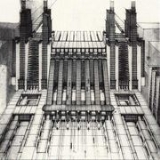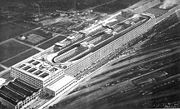
Futurist architecture
Encyclopedia

Filippo Tommaso Marinetti
Filippo Tommaso Emilio Marinetti was an Italian poet and editor, the founder of the Futurist movement, and a fascist ideologue.-Childhood and adolescence:...
, who produced its first manifesto, the Manifesto of Futurism
Futurist Manifesto
The Futurist Manifesto, written by the Italian poet Filippo Tommaso Marinetti, was published in the Italian newspaper Gazzetta dell'Emilia in Bologna on 5 February 1909, then in French as "Manifeste du futurisme" in the newspaper Le Figaro on 20 February 1909...
in 1909. The movement attracted not only poets, musicians, and artists (such as Umberto Boccioni
Umberto Boccioni
Umberto Boccioni was an Italian painter and sculptor. Like other Futurists, his work centered on the portrayal of movement , speed, and technology. He was born in Reggio Calabria, Italy.-Biography:...
, Giacomo Balla
Giacomo Balla
Giacomo Balla was an Italian painter.-Biography:Born in Turin, in the Piedmont region of Italy, the son of an industrial chemist, as a child Giacomo Balla studied music....
, Fortunato Depero
Fortunato Depero
Fortunato Depero was an Italian futurist painter, writer, sculptor and graphic designer.Although born in Fondo/Malosco , Depero grew up in Rovereto and it was here he first began exhibiting his works, while serving as an apprentice to a marble worker...
, and Enrico Prampolini
Enrico Prampolini
Enrico Prampolini was an Italian Futurist painter, sculptor and scenographer. He assisted in the design of the Exhibition of the Fascist Revolution and was active in Aeropainting....
) but also a number of architects. The latter group included Antonio Sant'Elia
Antonio Sant'Elia
Antonio Sant'Elia was an extremely influential Italian architect.-Life:Antonio Sant'Elia was born in Como, Lombardy. A builder by training, he opened a design office in Milan in 1912 and became involved with the Futurist movement...
, who, though building little, translated the Futurist vision into an urban form.
History

Filippo Tommaso Marinetti
Filippo Tommaso Emilio Marinetti was an Italian poet and editor, the founder of the Futurist movement, and a fascist ideologue.-Childhood and adolescence:...
, became the Manifesto dell’Architettura Futurista ("Manifesto of Futurist Architecture"). Also Boccioni worked on a similar manifesto, but Marinetti preferred Sant'Elia's paper.
Later in 1920, another manifesto was written by Virgilio Marchi, Manifesto dell’Architettura Futurista–Dinamica ("Manifesto of Dynamic Instinctive Dramatic Futurist Architecture"). Ottorino Aloisio worked in the style establishde by Marchi, one example being his Casa del Fascio in Asti
Asti
Asti is a city and comune of about 75,000 inhabitants located in the Piedmont region of northwestern Italy, about 55 kilometres east of Turin in the plain of the Tanaro River...
.
Another futurist manifesto related to architecture is the Manifesto dell’Arte Sacra Futurista ("Manifesto of Sacred Futurist Art") by Fillia (Luigi Colombo)
Fillìa
Fillìa was the name adopted by Luigi Colombo, an Italian artist associated with the second generation of Futurism.-Biography:Fillìa was born in Revello, Piedmont....
and Filippo Tommaso Marinetti
Filippo Tommaso Marinetti
Filippo Tommaso Emilio Marinetti was an Italian poet and editor, the founder of the Futurist movement, and a fascist ideologue.-Childhood and adolescence:...
, published in 1931.
On 27 January 1934 the Manifesto of Aerial Architecture by Angiolo Mazzoni
Angiolo Mazzoni
Angiolo Mazzoni was a prolific state architect and engineer of the Italian Fascist government of the 1920s and 1930s.Mazzoni designed hundreds of public buildings, post offices and train stations during the Interwar period in Italy...
and Marinetti. Mazzoni had publicly adhered to futurism only the year before. In this paper the Lingotto
Lingotto
Lingotto is a district of Turin, Italy, that named the Lingotto building in Via Nizza, which once was a huge automobile factory, constructed by Fiat. Built from 1916 and opened in 1923, the design was unusual in that it had five floors, with raw materials going in at the ground floor, and cars...
factory by Giacomo Matté-Trucco is defined as the first Futurist constructive invention. Mazzoni himself in that years worked on building considered masterpiece of futurist architecture, like the Heating plant and Main controls cabin
Heating plant and main controls cabin, Florence
The Heating plant and Main controls cabin is a technical facilities building in Firenze Santa Maria Novella railway station designed by architect Angiolo Mazzoni in 1929...
at Santa Maria Novella railway station, in Florence
Florence
Florence is the capital city of the Italian region of Tuscany and of the province of Florence. It is the most populous city in Tuscany, with approximately 370,000 inhabitants, expanding to over 1.5 million in the metropolitan area....
.
After World War II Futurism toned down considerably, redefining itself in the context of Space Age
Space Age
The Space Age is a time period encompassing the activities related to the Space Race, space exploration, space technology, and the cultural developments influenced by these events. The Space Age is generally considered to have begun with Sputnik...
trends, the car culture and the fascination with plastic
Plastic
A plastic material is any of a wide range of synthetic or semi-synthetic organic solids used in the manufacture of industrial products. Plastics are typically polymers of high molecular mass, and may contain other substances to improve performance and/or reduce production costs...
. An example of this type of futurism is the Googie architecture of 1950s California
California
California is a state located on the West Coast of the United States. It is by far the most populous U.S. state, and the third-largest by land area...
.
Sources
- VV.AA. Angiolo Mazzoni e l'Architettura Futurista, Supplement of CE.S.A.R. September/December 2008 (Available at )

